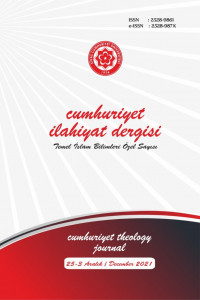20. Asırda Hazırlanan Kazakça Meâllerde Müteşâbih İfadelerin Çevirisi Problemi
The Translation Issue of Mutashābih Expressions in the Example of Kazakh Translations Prepared in the 20th Century
Author(s): Daniyar SametSubject(s): Semiotics / Semiology, Modern Age, Islam studies, Semantics, Translation Studies, Qur’anic studies
Published by: Cumhuriyet Üniversitesi İlahyat Fakültesi
Keywords: Tafsīr; Ta'wil; Kazakh Meal; Mutashābih; Khabarī Attributes;
Summary/Abstract: The Qurʾān is certainly the last of the divine teachings and the most perfect. While this holy book has a perfect miraculous feature, especially since its rules are valid until the Day of Judgment, it also contains many unique features in terms of style and content. The Qurʾān firstly asks people to understand it thoroughly and live it in their lives. In order for them to live, they must first correctly understand the messages that the Qurʾān gave to people. In order to understand it well, they must either know the language it uses or try to understand it through translations. It is obvious that it is not practically possible for all people to know Arabic. Because people have different languages, cultures, and races due to the wisdom of Allah. Therefore, nations who speak different languages in the world have translated the Qurʾān into their own languages in order to understand what the Qurʾān means and to apply its rules to their lives. It is a fact that the Qurʾān was partially translated into different languages during the reign of Prophet Muḥammad (pbuh). As a matter of fact, Salmān al-Fārisī's (d. 36/656 [?]) (r.a.) translation of Surah Fatiha into Persian and the translation of the verses in the letters that our Prophet (pbuh) had written in order to invite communities speaking different languages to Islam can be given as an example to this situation. The Qurʾān has been many times interpreted, mealed, and translated into different languages of the world since the time it was revealed to the present day. There is no doubt that the translation of the Qurʾān will continue as long as people speak different languages until the end of the worldly life. It is mentioned in the sources that the first translation of the Qurʾān into Kazakh was made by Mūsā Jārullāh (d. 1368/1949) at the beginning of the 20th century. However, this translated work was not published and remained only as a manuscript. Another important issue is the scholars' thoughts on the language of the translation in question. As a matter of fact, according to them, the language of the translation is Tatar, not Kazakh. In this study named as ‘TheTranslation Issue of Mutashābih Expressions in the Example of Kazakh Translations Prepared in the 20th Century’ five important Kazakh translation works were examined prepared in the 20th century, named as Qurʾān Shareef Kazakhsha Magina Jane Tusinigi of Khalifa Altay (d. 1424/2003), Qurʾān Kareem Kazakhsha Avdarmasi of Azīz Akituli (d. 1434/2013) and Makash Akituli (d. 1424/2003), Qurʾān Kareem Jane Onin Kazakhsha Maginasi of Nurali Oserov (d. 1435/2014) and Jumabay Istaeev (d. 1422/2001), Qurʾān Kareem of Ratbek Nisanbayuli and Vahap Kidirhanuli and Qurʾān Kareem Kazakhsha Magina Jane Tusinigi of Vahap Kidirhanuli. First, the lives of the authors, the general evaluations of those works, the language of the published works, the problematic aspects, and technical features in terms of method and content were discussed. In the next step, how the translators translated the khabarī attributes, which are among the mutashâbih expressions in the Holy Qurʾān, into Kazakh and the problems that these translations cause are addressed. One of the most important subjects and issues of the science of tafsīr, which has an important place in the scientific tradition of the Islamic religion, is undoubtedly the issue of mutashabihs in the Qurʾān, and the subject has been discussed by especially theologians in many scientific traditions in the historical process. Allah almighty, the Creator of all realms, informs people of some of his qualities in the Qurʾān so that we can know himi and have knowledge of what kind of being Allah is. Through revelation, Allah introduced himself to his believers via an understandable language framework which includes appropriate comparisons and metaphors. This presentation has also been realized through the ḥadīths of Prophet Muḥammad (pbuh). Therefore, these two sources inform us Allah's qualities Khabarī qualities refer to those that are reported in verses and ḥadīths and that are fixed by revelation. In this article, the eleven verses in which the mutashābih adjectives that are attributed to Allah, such as yad, vach, ayn, istiwa, kabza, macī', and etā, are considered as examples. Understanding the qualities of Allah correctly is very important in terms of having a affirmative and corrective faith. This study aims to reveal what kind of kalamī view Kazakh translators use when interpreting mutashābih expressions into Kazakh. In addition, in the study, mutashābih expressions should be interpreted within the boundaries determined by the Qur'ān and the Science of Ḥadīth, with expressions that can be accepted by the human mind, without falling into simile and embody. To our knowledge this is the first study focusing on on the issue of translating mutashābih expressions in Kazakh translations made in Kazakhstan in the 20th century.
Journal: Cumhuriyet İlahiyat Dergisi
- Issue Year: 25/2021
- Issue No: 3
- Page Range: 1181-1202
- Page Count: 22
- Language: Turkish

